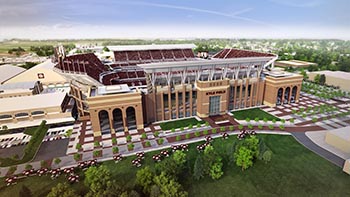 COLLEGE STATION, Texas — The largest athletic facility redevelopment in collegiate history will soon begin at Texas A&M University with the $450 million Kyle Field Redevelopment Project.
COLLEGE STATION, Texas — The largest athletic facility redevelopment in collegiate history will soon begin at Texas A&M University with the $450 million Kyle Field Redevelopment Project.
Designed by Populous, headquartered in Kansas City, Mo., the design includes seating capacity for 102,500 spectators, a 20,000-seat increase from the current Kyle Field.
“The redevelopment of Kyle Field will result in the finest collegiate football facility in the country and will serve as a benchmark moving forward for future redevelopment projects at colleges across the nation,” said Earl Santee, senior principal at Populous. “This project is entirely focused on preserving the incredible tradition and iconic elements of Kyle Field while defining the future of Aggie football by enhancing a game day experience unlike any other. When complete, Kyle Field will serve as a living monument to the unique culture and the storied history that is Texas A&M.”
A joint venture between Vaughn Construction, headquartered in Houston, and Tulsa, Okla.-headquartered Manhattan Construction Company will lead construction on the redevelopment. Construction is expected to begin in November and complete in August 2015.
Funding for the project will be funded from annual seat licenses, Kyle Field Campaign donations, Texas A&M students and local government agencies. With expanded seating options, the stadium will also undergo a complete reseating. Approximately 120 suites, a private club in a 3,900-seat field box and three different types of loge seating will be added to the stadium.
The much-anticipated project is expected to transform the school’s gameday experience.
“In my short time here in Aggieland, I have witnessed firsthand how Aggies respond to challenges and opportunities. This significant project is a shared vision and shared experience for all of our fans,” said Eric Hyman, director of athletics for the university, in a statement. “Upon completion, we will have immense pride in Kyle Field. It will be unmatched anywhere in the country, with Texas A&M’s history and traditions woven throughout the stadium and its surroundings.”
Other features of the stadium, which will include a brick, glass and limestone façade, include two large canopies on the east and west sidelines to provide shade for fans and amplify noise, the 30,000-square-foot Hall of Champions, and numerous plazas and gathering spaces for fans.
Construction will take place in three phases beginning with the demolition of the first deck of the east side, the reconstruction of the first deck and the construction of the south endzone. Phase II, expected to begin in November 2014, will demolish the entire west side of the stadium, complete endzone construction and reconstruct the west side of the stadium.
The Texas Higher Education Coordinating Board recently gave formal approval to the trailblazing project.
"We appreciate the consideration and support of this groundbreaking project by the Texas Higher Education Coordinating Board," said John Sharp, Texas A&M university system chancellor. "Their formal approval paves the way for the most ambitious redevelopment ever envisioned."
In late July, the university approved the construction timeline with expectations of completion in time for the 2015 season.
“As we have seen with Texas A&M’s transition into the Southeastern Conference, athletics can play a key role in increasing the visibility of the entire university,” said Texas A&M President R. Bowen Loftin in a statement. “The Kyle Field project is yet another element of enhancing Texas A&M’s profile.”
To track the construction progress live, click here.

